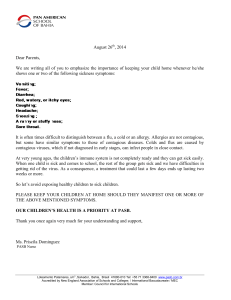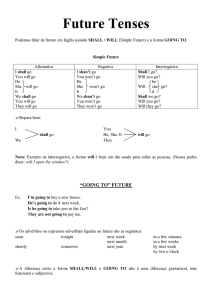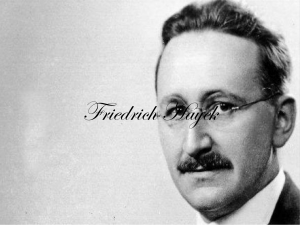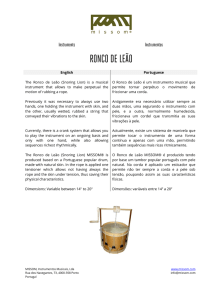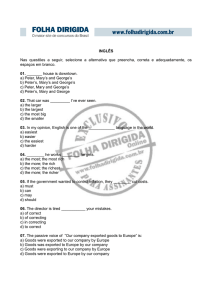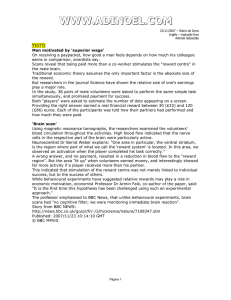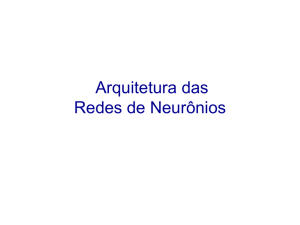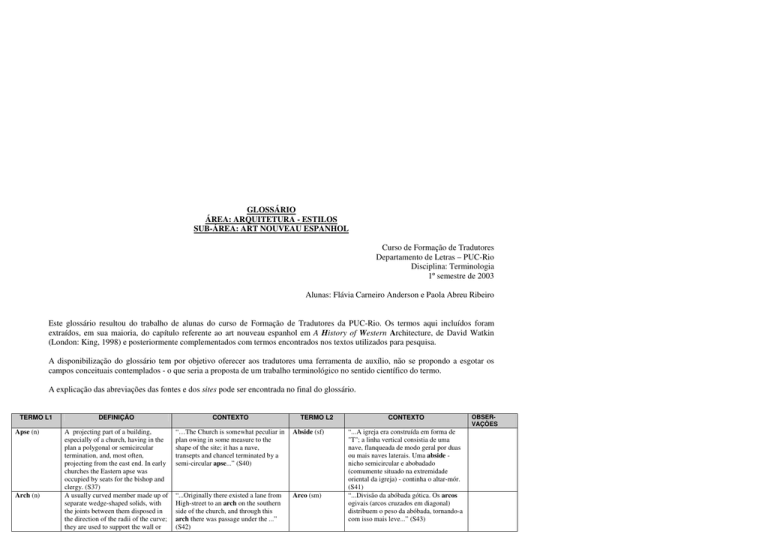
GLOSSÁRIO
ÁREA: ARQUITETURA - ESTILOS
SUB-ÁREA: ART NOUVEAU ESPANHOL
Curso de Formação de Tradutores
Departamento de Letras – PUC-Rio
Disciplina: Terminologia
1º semestre de 2003
Alunas: Flávia Carneiro Anderson e Paola Abreu Ribeiro
Este glossário resultou do trabalho de alunas do curso de Formação de Tradutores da PUC-Rio. Os termos aqui incluídos foram
extraídos, em sua maioria, do capítulo referente ao art nouveau espanhol em A History of Western Architecture, de David Watkin
(London: King, 1998) e posteriormente complementados com termos encontrados nos textos utilizados para pesquisa.
A disponibilização do glossário tem por objetivo oferecer aos tradutores uma ferramenta de auxílio, não se propondo a esgotar os
campos conceituais contemplados - o que seria a proposta de um trabalho terminológico no sentido científico do termo.
A explicação das abreviações das fontes e dos sites pode ser encontrada no final do glossário.
TERMO L1
Apse (n)
Arch (n)
DEFINIÇÃO
CONTEXTO
TERMO L2
A projecting part of a building,
especially of a church, having in the
plan a polygonal or semicircular
termination, and, most often,
projecting from the east end. In early
churches the Eastern apse was
occupied by seats for the bishop and
clergy. (S37)
A usually curved member made up of
separate wedge-shaped solids, with
the joints between them disposed in
the direction of the radii of the curve;
they are used to support the wall or
“…The Church is somewhat peculiar in
plan owing in some measure to the
shape of the site; it has a nave,
transepts and chancel terminated by a
semi-circular apse...” (S40)
Abside (sf)
“...Originally there existed a lane from
High-street to an arch on the southern
side of the church, and through this
arch there was passage under the ...”
(S42)
Arco (sm)
CONTEXTO
“...A igreja era construída em forma de
"T"; a linha vertical consistia de uma
nave, flanqueada de modo geral por duas
ou mais naves laterais. Uma abside nicho semicircular e abobadado
(comumente situado na extremidade
oriental da igreja) - continha o altar-mór.
(S41)
“...Divisão da abóbada gótica. Os arcos
ogivais (arcos cruzados em diagonal)
distribuem o peso da abóbada, tornando-a
com isso mais leve...” (S43)
OBSERVAÇÒES
Arch,
parabolic
(n+a)
other weight above an opening. In
this sense arches are segmental,
round (i.e. semicircular), or
pointed.(S37)
An arch that relates to, resembles, or
has the form of a parabola
(ADE)
Arch, pointed
(n+a)
An arch that ends in a point or sharp
angle.(AD)
Art nouveau
(n)
French for "The New Art." An art
movement and style of decoration
and architecture of the late nineteenth
and early twentieth centuries,
characterized particularly by the
depiction of leaves and flowers in
undulating lines, often flowing vines.
(S1)
“The use of parabolic, as opposed to
pointed or semicircular arches, was
also to be characteristic of Gaudí, who
chose them for their static quality, not
just because of their novel
profile.”(HWA)
Arco parabólico
(s+a)
“O arco parabólico é o que se parece
com a parábola ou com a catenária.”
(S19)
“The use of parabolic, as opposed to
pointed or semicircular arches, was
also to be characteristic of Gaudí, who
chose them for their static quality, not
just because of their novel
profile.”(HWA)
“...The openings in the first and second
floors have balconies made in forged
iron, as it is common in Catalan Art
Nouveau...” (S81)
Arco ogival
(s+a)
“O arco ogival ou em ponta é típico do
estilo gótico e permitia sustentar
abóbadas elevadas.” (S18)
Art nouveau
(sm)
“...Na verdade, Gaudí se insere em um
movimento artístico e arquitetônico
conhecido como Art Nouveau, cujos
detalhes exprimiam a preocupação com a
beleza e a leveza sensual da natureza em
formas estilizadas, modeladas em ferro,
vidro e madeira...”(S5)
Artifice (n)
1. Subtle but base deception;
trickery. A character of Mannerist
art. (S44)
“... That the great monuments of the
Greeks were imitations in stone of
earlier wooden temples makes the
architecture that followed imitations of
imitations. This artifice at the heart of
classicism is it's strength...” (S45)
Artifício (sm)
Atrium (n)
An inner courtyard of a home or
other building that is open to the sky
or covered by a skylight.
(S39)
“...The atrium's indoor garden, which
is larger than one-third of an acre, is
roofed by a "space-frame" of glass
pyramids ...” (S47)
Átrio (sm)
Balcony (n)
A platform projecting from the wall
of a building, usually resting on
“...The iridescent mosaic tiles and
undulating gallery gives the house a
Balcão (sm)
“...Em minha palestra eu mostro como a
propaganda usa táticas de superposição
para desestabilizar o espaço entre o
anúncio e o edifício como um artifício
para chamar a atenção do observador...”
( S46)
“...A arquitetura singular, definida pelo
prisma de vidro transparente que abriga o
átrio, é o grande destaque do edifício
Brigadeiro II...” (S48)
“...No andar superior, o balanço à
esquerda é um balcão corrido contíguo ao
Portugal: arte
nova.
Pode ser
também
utilizado com
o artigo
feminino (a art
nouveau)
Baroque (a)
Buttress (n)
brackets or consoles, and enclosed by
a parapet; for example as a balcony
in front of a window. The term is
also applied to a projecting gallery in
places of amusement; for example
the balcony in a theatre. (S37)
Of, relating to, or being a style of art
and architecture prevalent from the
latter part of the 16th century to the
latter part of the 18th century,
marked by dynamic opposition and
energy, by the use of curved and
plastic figures, and especially in its
later phases by elaborate and
sometimes grotesque ornamentation,
and represented typically by the
sculpture of Bernini and the painting
of Rubens (WTN)
A projecting mass of masonry, used
for resisting the outward thrust of an
arch, or for ornament and symmetry.
When an external projection is used
merely to stiffen a wall, it is called a
pier, rather than a buttress. (S37)
Ceramic tile
(n)
Any of a wide range of sturdy floor
and wall tiles made from fired clay
and set with grout. May be glazed or
unglazed. Colors and finishes vary.
May be used indoors or out.
( S39)
Chevet ( n)
The extreme end of the chancel or
choir in a church; the term being
properly used to describe the round
or polygonal part. (S37)
cheerful expression until one's eyes rise
to the heavy wrought-iron balcony,
which rises up like masks...” (S49)
jantar, o frontal se divide...” ( S50)
Many writers draw no distinction
between the words rococo and
baroque, which are far from
synonymous— (WTN)
Barroco (a)
“.... Não fez parte de nenhuma escola. Foi
buscar no simbolismo as referências da
natureza, a ornamentação no Barroco e o
sensual na Art Noveau. Teve um destino
irônico, praticando o que acreditava...”
(S51)
“...rather than uniformly thickened. For
a load-bearing brick wall more than 8 ft
(2 m) high a buttress is used every 20
ft (6 m). The decorative possibilities of
the buttress were discovered in the
ancient temples at Abu Shahrein in
Mesopotamia (3500–3000 B.C.), where
they were used both as utilitarian and
decorative forms...”
(S52)
Botaréu (sm)
“...que compreende um gracioso alpendre
de quatro arcadas redondas e
contrafortadas, nascendo do chamado
botaréu angular sul, de andares, uma
pequena escada de acesso ao campanário
...” (S53)
Modernist architects were much given
to using ceramic tiles but the
unprecedented structural systems Gaudí
devised in order to be able to
incorporate both natural and glazed
tiles into his creations set him apart
from the rest. (S54)
“... The chevet of the church is semicircular. As a whole the building it
homogeneous and has much to
fascinate the visitor. ..” (S56)
Azulejo (sm)
“... Gaudí trabalhava nela como quem faz
um castelo de areia, salpicando detalhes e
ignorando as linhas retas. Sempre usando
material barato, como cacos de garrafas e
pratos, azulejos e cerâmica...” (S55)
Cabeceira (sf)
“...O que de mais importante resta da
igreja é a cabeceira formada por capelamor, cuja abóbada foi reconstruída, e
quatro capelas secundárias
intercomunicantes...”
(S57)
Chimneypot
(n)
A short earthenware or metal pipe
that is placed on the top of a chimney
in order to increase the draft.
(MERL)
Colonnade (n)
A row of columns, frequently
covered with a roof projecting from
an adjacent building. Colonnades
were common in ancient Greece.
When in front of a building, it is
called a portico; when surrounding a
building or an open court or square, it
is called a peristyle. (S 37)
An area of ground that is surrounded
by buildings, lies inside a large
building, or is adjacent to a building
and enclosed by walls. (MERL)
Courtyard (n)
Craftmanship
(n)
The capacity to make or
manufacture (an object, objects,
product, etc.) with skill and careful
attention to detail.(AD)
Cruciform (a)
Shaped like a cross
(MERL)
Cupola (n)
A roof or ceiling in the form of a
dome (MERL)
“The roofscape of the Palau Güell,
forming an abstract sculptural
composition with chimneypots and
ventilators faced in coloured glass, tiles
and mosaic, also set a precedent which
Gaudí was often to follow.” (HWA)
“...The exterior of the cupola is in three
stages with a magnificent dome over a
collonade of columns. The exterior
portico is modelled on the Roman
Pantheon and has ornate sculpture and
22 columns...’ (S58)
“Gaudí had a freer hand in the much
larger and more unified Casa Milá
(1906-10), which he built round two
nearly circular courtyards in the same
street as the Casa Batló, the fashionable
Paseo de Gracia.”(HWA)
“…Art Nouveau architects who, in
addition, shared the belief of men like
Ruskin and Cuypers in the necessity of
reviving craftsmanship.” (HWA)
“The Sagrada Familia was begun in
1882 from designs by Francesc de
Paula del Villar I Carmona as a
conventional cruciform Gothic
church.”(HWA)
“The spacial variety and complexity of
the interior(…), culminates in the
central domed hall, which rises to the
top of the building and is lit by a
cupola lined with hexagonal tiles and
punctuated with numerous small
apertures like stars.” (HWA)
Chaminé (sf)
“...Uma vez mais Gaudí recusa os ângulos
e as esquinas e as chaminés assumem
proporções ainda não experimentadas
antes...”(S13)
Mais
especificamente, “cano
de chaminé”
Colunata (sf)
"...estilos do passado. Assim, no Parque
Güell há uma colunata dórica, na Casa
Vicens, elementos hispano-árabes, etc...."
(S59)
Variação:
colunada
Pátio (sm)
“É a estrutura do que era o quartelgeneral dos Cavaleiros de S. João, um
grande conjunto de edifícios (cerca de
4.500 m2) com muralhas e inúmeras salas
construídas em torno de um amplo pátio
central aberto.” (S23)
“Já houve o tempo em que se julgava arte
pela habilidade artesanal e pela
interferência das mãos do autor.” (S7)
Habilidade
artesanal (s+a)
Cruciforme
(sm)
“Orientado a sul, o templo tem planta
cruciforme, com o transepto semelhante
às naves.” (S25)
Cúpula (sf)
“...As características predominantes
seriam a cúpula (parte superior e côncava
dos edifícios) e a planta de eixo central,
também chamada de planta de cruz grega
(quatro braços iguais). A cúpula
procurava reproduzir a abóbada celeste...”
(S15)
Domed hall
(a+n)
A large room or lobby that has a
dome. (ADE)
Doric column
(a+n)
A Greek-style column that has a
simple decoration around the top,
usually a smooth or slightly rounded
band of wood, stone or plaster. (S4)
Entablature
In classical architecture, the section
that lies between the columns and the
roof. It comprises, from bottom to
top, the architrave, frieze, and
cornice. (MERL)
(n)
Façade (n)
The face of a building, especially the
principal or front face showing its
most prominent architectural features
(MERL)
Finial (n)
A carved decoration at the top of a
gable, spire, or arched structure.
(MERL)
Flying
buttress (n)
It is a contrivance for taking up the
thrust of a roof or vault which can
not be supported by ordinary
buttresses. It consists of a straight bar
“The spacial variety and complexity of
the interior(…), culminates in the
central domed hall, which rises to the
top of the building and is lit by a cupola
lined with hexagonal tiles and
punctuated with numerous small
apertures like stars.” (HWA)
“The principal building is the Greek
Theatre, with tilted Greek Doric
columns surmounted by an undulating
entablature which, decorated with
moulded ceramics, also serves as a
bench terminating the roof
terrace.”(HWA)
“The principal building is the Greek
Theatre, with tilted Greek Doric
columns surmounted by an undulating
entablature which, decorated with
moulded ceramics, also serves as a
bench terminating the roof
terrace.”(HWA)
“The stone façade of the Casa Milá is
enlivened with balconies of wrought
iron tortured so as to resemble
glistening bunches of seething
seaweed, perhaps the most vivacious
Art Nouveau metalwork anywhere”.
(HWA)
“In 1903-30 the Nativity transept, with
its gables resembling stalactites, was
completed with the addition of towers
and openwork cone-shaped spires of
astonishing height, crowned with
tentacle-like finials of coloured broken
tiling.” (HWA)
“...The columns are not vertical but
near the top (shown) have an inward
branching making a parabola that
Saguão
abobadado
(s+a)
Coluna dórica
(s+a)
Entablamento
(sm)
Fachada
(sf)
“As mais belas residências de estilo árabe
encontram-se em todas as capitais do
Mundo Árabe, entra-se sempre nessas
casas por um saguão abobadado e
estreito onde estão os criados, e em cujo
extremo se desemboca num grande
pátio.” (S14)
“Ao contrário da coluna dórica, a jônica
não assenta diretamente sobre patamares,
mas tem uma base - plinto - que assume
diversas formas.” (S16)
“A escolha do estilo levou a uma
composição dos alçados exteriores,
simétricos dois a dois, onde se empregou
a ordem dórica, sem caneluras no fuste,
em pilastras monumentais que vencem os
dois andares do edifício até o
entablamento que o circunda.” (S17)
“Compreende a fachada do edifício todas
as suas partes externas
visíveis e também as não visíveis (frente,
fundos e laterais).” (S22)
Remate (sm)
“No interior, a nave, do lado da Epístola,
tem um púlpito com balaustrada
de madeira, suportado por uma mísula em
granito com remate em volutas.” (S31)
Arcobotante
(sm)
“...a planta constitui uma reinterpretação
dos modelos góticos, havendo colunas
inclinadas que assumem o papel de
arcobotantes; e, sobretudo, prevalece
Variação L1,
arcboutant ;
L2 arco
Gable (n)
Gothic (n)
Grille (n)
Grotesque
(adj, n)
of masonry, usually sloping, carried
on an arch, and a solid pier or
buttress sufficient to receive the
thrust. The word is generally applied
only to the straight bar with
supporting arch. (S37)
The portion of the front or side of a
building enclosed by or masking
the end of a pitched roof. (RHW)
General term for a style of
architecture and ornament prevalent
between the twelfth and sixteenth
centuries, considered old-fashioned
in the seventeenth and early
eighteenth centuries, characterised by
pointed arches, ribbed vaulting, and
flying buttresses, and by grotesque
decorations; when it came back into
fashion in the mid-1700s, it was
celebrated as a symbol of British
patriotism. (S3)
1 a : a grating (as of wrought iron,
bronze, or wood) forming an often
elaborate openwork barrier, screen,
or cover (as to a door, window, or
other opening) (WTN)
In art, a kind of ornament used
in antiquity consisting of
representations of medallions,
sphinxes, foliage, and imaginary
creatures.(S68)
eliminates the need for flying
buttresses...” (S61)
uma relação orgânica entre o interior e o
exterior, conseguida mercê de
originalíssimas soluções de problemas
estruturais...” (S62)
“...Its symmetry, balance and orderly
rhythm are unusual for Gaudí's works.
However, the curves and double gable
at the top, the projecting oriel at the
entrance--almost baroque in its drama,
and isolated witty details are
modernista elements. (S63)
Frontão (sm)
“...Em meio de quadra, a Casa Calvet
(1898-99), de planta simples e quase
simétrica, é animada sutilmente, de frente
para a rua, pela rusticação da fachada
pétrea com as sacadas e frontões curvos,
enquanto a fachada s...” (S64)
“Antoni Gaudí began as a Gothic
Revivalist but in his characteristically
exuberant Casa Vicens (…) the railings
and gates have an early Art Nouveau
flavour.”(HWA)
Gótico (a)
“A arquitetura gótica se apoiava nos
princípios de um forte simbolismo
teológico, fruto do mais puro pensamento
escolástico: as paredes eram a base
espiritual da Igreja, os pilares
representavam os santos, e os arcos e os
nervos eram o caminho para Deus.” (S8)
“...The work stretched out for thirteen
years due to lack of funds, until finally
Jeroni Martorell was able to make the
magnificent wrought-iron grille that
closes the grotto...”
(S66)
Grade (sf)
“...During the Gothic Revival in Britain
and France, the grotesque represented
a world turned upside down, where, for
instance, monsters guarded the
church....” (S69)
Grotesco
(s, adj)
“... No Brasil, o art nouveau chegou
através da influência francesa,
especialmente na decoração de interiores,
grades e objetos de ferro forjado. A
confeitaria Colombo, no centro da cidade
do Rio de Janeiro, é um exemplo deste
estilo...” (S67)
“...Mais tarde acentuam-se a sua maldade
e o seu caráter disforme e assustador, que
irá aos poucos se tornando menos
demoníaco e mais caricato, característica
que evidencia o termo grotesco, dado o
exagero nas poses e expressões dos
personagens...”
(S70)
botante
Layout (n)
A design or plan that shows the way
things are arranged . (ADE)
Mosaic (n)
The use of small pieces of glass,
stone, or tile (tesserae), or pebbles, to
create and image on a flat surface
such as floor, wall, or ceiling
(S71)
Mullion (n)
A vertical piece of stone, metal, or
wood that divides the panes of a
window or the panels of a screen.
(MERL)
Nave (n)
The long central hall of a crossshaped church, often with pillars on
each side, where the congregation
sits (MERL)
Openwork (n)
Decorative items that make use of
patterns of holes, for example
wrought-iron work, fretwork, or lace
(MERL)
Organic
Architecture
(a+n)
It is a term Frank Lloyd Wright used
to describe his approach to
architectural design. The philosophy
grew from the ideas of Wright's
mentor, Louis Sullivan, who believed
that “form follows function.” Wright
argued that “form and function are
one.” (S82)
“Domènech’s masterpieces, grandiose
in scale and exotic in detail, are the
Hospital of S.Pau, Barcelona (190210), and the Palau de la Música
Catalana (1905-8), the former with an
extended layout like an English garden
city.”(HWA)
“... Sagrada Familia (1883), is a church
reminiscent of the Gothic tradition, but
the ornate use of sculpture and mosaic
tiling is unmistakably Gaudi....”
(S72)
Projeto (sm)
“Manuel Francisco Lisboa é o autor do
projeto da Igreja de Nossa Senhora do
Carmo,
depois alterado por seu filho, Antônio
Francisco Lisboa, o Aleijadinho.” (S36)
Mosaico (sm)
“…their interiors were iron cages with
conventional partitions largely replaced
by slender iron mullions so as to
obstruct the sales areas as little as
possible.”
(HWA)
“Work still continues slowly on the
nave, structurally the most original part
of the whole church(…)” (HWA)
Mainel (sm)
“...a restauração dos elementos originais
catalogados como os mais importantes e
em bom estado de conservação, entre eles
as colunas com capitéis de gesso, as
luminárias, o piso de mosaico veneziano
e as portas em latão... “(S73)
“No registo inferior, ao centro do mainél
que divide a porta, uma estátua do Infante
D. Henrique. O portal é ladeado por dois
janelões de arco redondo. ...” (S9)
“In 1903-30 the Nativity transept, with
its gables resembling stalactites, was
completed with the addition of towers
and openwork cone-shaped spires of
astonishing height, crowned with
tentacle-like finials of coloured broken
tiling.”(HWA)
“So here I stand before you preaching
organic architecture: declaring organic
architecture to be the modern ideal
and the teaching so much needed if we
are to see the whole of life, and to now
serve the whole of life, holding no
‘traditions’ essential to the great
TRADITION.
Nave (sf)
“Um dos motivos para a elaboração do
projeto foi a atual via-sacra da catedral
que fica no fundo da nave da igreja.”
(S32)
Vazado (a)
“O átrio será ainda mais utilizado quando
trepadeiras tomarem conta de parte da
"arapuca" metálica que lhe serve de teto
vazado.” (S29)
Arquitetura
Orgânica
(s+a)
“Biografia, lista de projetos construídos,
depoimentos, informações sobre Taliesin
West, arquivos, links, etc - tudo
relacionado com o grande mestre da
arquitetura orgânica encontra-se no site
oficial da Fundação Frank Lloyd Wright.”
(S28)
Também podese utilizar
“coluneta”
(FLK)
Organic
design (a+n)
Piano nobile
(n+a)
A design style characterized by fluid
transitions, smoothed edges, things
blending in with each other, and
rounded forms. Many 20th century
artists favored a style called
"biomorphic abstraction," where
continuous curvilinear shapes
suggest living organisms. (S2)
The main floor of a building where
the most important rooms would be
located: literally "noble storey" in
Italian. (S38)
Pier (n)
A pillar, especially a rectangular one
supporting the end of an arch, lintel,
or vault. (MERL)
Prop (n)
A rigid object such as a beam, stake,
or pole that supports something or
holds it in place. (MERL)
Railing (n)
A fencelike barrier composed of
one or more horizontal rails
supported by widely spaced
uprights; balustrade. (RHW)
Roofscape (n)
The external upper covering of a
house or other building that may
have a terrace, offer a view or have a
visual character. (ADW)
Spire (n)
The name given to the roof of a
tower when of a pyramidal form and
“The calls for structural honesty by
Viollet-le-Duc and for organic design
by Sullivan were also given expression
by art nouveau architects…”
(HWA)
Desenho
orgânico (s+a)
“Platibanda em concreto com vazados
geométricos simulando os desenhos dos
gradis de ferro tão em uso na época.
Detalhe da porta principal com desenho
orgânico, lembra a asa de um inseto,
muito utilizado pelas propostas art decor
e art nouveau.” (S6)
“...The reconstructed Piano Nobile,
believed to have been the official royal
residence and reception rooms, is on
the west side of the court. This upper
floor provides an excellent view of the
palace storerooms...”
(S74)
“He treated the piers as tree-trunks,
tilting them inwards so as to counteract
the thrust of the vault without recourse
to any props or flying buttresses, which
he dismissed as ‘crutches’.”(HWA)
“He treated the piers as tree-trunks,
tilting them inwards so as to counteract
the thrust of the vault without recourse
to any props or flying buttresses,
which he dismissed as ‘crutches’.”
(HWA)
“…But in his characteristically
exuberant Casa Vicens (…), the
railings and gates have an early Art
Nouveau flavour.”(HWA)
Piano nobile
(s+a)
“...O seu uso significa, como em
Corbusier, a "reinterpretação" do
princípio clássico do podium, substituída
a massa edificada que se ocupava de
separar o piano nobile do solo pelo vazio
entre colunas...” (S75)
Portugal:andar
nobre
Pilastra (sf)
“Outro problema freqüente que ocorre
após a conclusão da obra é a insatisfação
do(a) proprietário(a) com a posição de
alguma pilastra.” (S33)
Ou pilar
Estaca (sf)
“A estaca fixa tem a finalidade de manter
as linhas de uma cerca sempre a uma
mesma distância, permitindo aumentar a
distância entre os moirões.” (S34)
Também podese utilizar
“colunas ou
apoios”
Balaustrada (sf)
“O terraço era cercado por uma
balaustrada de bronze e contava com
uma iluminação especial, fornecida por
lampiões de óleo de peixe...” (S10)
“The roofscape of the Palau Güell,
forming an abstract sculptural
composition with chimneypots and
ventilators faced in coloured glass, tiles
and mosaic, also set a precedent which
Gaudí was often to follow.” (HWA)
“...The spires and ceiling support are of
catenary arches - the asymmetric form
Teto-terraço
(sm)
“As dezoito chaminés levantadas no tetoterraço se vestem com cacos de vidro,
pedra e azulejos à maneira de pinhas ou
ciprestes rodeando a espira sobre a
cúpula.” (S12)
Flecha (sf)
“E as altíssimas naves das catedrais
góticas coroadas por magníficas torres e
Também
chamada de
Transept (n)
Turret (n)
high in proportion to its width. The
name is also given to the pyramidal
or aspiring termination of a tower
which can not be said to have a roof,
such as that of Strasburg cathedral;
and to the tapering part of a steeple,
or the steeple itself. (S37)
The cross aisles of a church,
projecting at right angles from the
nave or choir. In the basilicas, they
often had no projection at the two
ends. In Gothic churches these
project greatly, and should be called
the arms of the transept. It is
common, however, to speak of the
arms themselves as the transepts.
(S37)
A small rounded tower that projects
from a wall or corner of a large
building such as a castle (MERL)
Vault (n)
An arched structure of stone, brick,
wood, or plaster that forms a ceiling
or roof. (MERL)
Wrought iron
(a+n)
A highly refined form of iron that is
easy to shape but is strong and fairly
resistant to rust, widely used for
decorative metalwork. Wrought iron
contains only 1 to 3 per cent of
silicate slag distributed in fibers
within the iron, thus making it very
malleable. (MERL)
esbeltas flechas, que com freqüência
vieram abaixo, foram erguidas para que,
nas palavras de Christian Norberg-Schulz,
“Deus se acercará do homem”. (S83)
of a parabola that he developed doing
Casa Mila. ...” (S76)
“...The south transept at Hunston is as
big as the nave, creating a most unusual
effect in this tiny village church…”
(S77)
Transepto (sm)
“O transepto é constituído por dois
braços, o direito e o esquerdo. No Braço
esquerdo do transepto encontra-se a
imagem de Nossa Senhora da
Vandoma...” (S78)
“At one side rises a turret capped with
a cross and the initials in gold of the
Holy Family.” (HWA)
Torreão (sm)
“He treated the piers as tree-trunks,
tilting them inwards so as to counteract
the thrust of the vault without recourse
to any props or flying buttresses, which
he dismissed as ‘crutches’.” (HWA)
“The stone façade of the Casa Milá is
enlivened with balconies of wrought
iron tortured so as to resemble
glistening bunches of seething
seaweed, perhaps the most vivacious
Art Nouveau metalwork anywhere”.
(HWA)
Abóbada (sf)
“No topo desta torre, ou Torreão Central,
encontrava-se uma plataforma
devidamente preparada para a colocação
de peças de fogo, aumentando o poder
defensivo da Fortaleza de Sagres.” (S21)
“As colunas góticas eram formadas de
feixes de pilares, eram grossas, fortes
e grandes e tinham a função de sustentar
toda a estrutura da abóbada.” (S20)
Abreviaturas utilizadas no fichamento e referências bibliográficas
Ferro forjado
(s+a)
“Utilizando o ferro forjado como
matéria prima, produziam-se ferraduras,
camas, bancos de jardim e gradeamento
para varandas ou janelas.” (S24)
coruchéu ou
agulha
Informações gramaticais:
L1: n. = noun
a. = adjective
v. = verb
L2: s. = substantivo
m. = masculino
f.= feminino
a. = adjetivo
v. = verbo
Referências bibliográficas:
Teórica:
ALVES, Ieda M. (1996) “Definição terminológica: da teoria ã prática”. TradTerm 3, p. 125-136.
Fontes dos termos:
AH - Houaiss, Antonio
CAL - Cambridge Advanced Learner’s Dictionary
HWA – Watkin, David (1998) A History of Western Architecture. London: King.
MERL - Microsoft® Encarta® Reference Library 2003.
AD - Adaptação
ADE – Adaptação do Microsoft® Encarta® Reference Library 2003
ADW – Adaptação do Random House Webster’s Unabridged Dictionary e do site
www.cityofseattle.net/npo/plans/elake/appendices.pdf
RHW - Random House Webster’s Unabridged Dictionary
WTN- Webster Third New Dictionary
FLK - Wright, Frank Lloyd. An Organic Architecture, 1939
Sites:
S 1. http://www.artlex.com/ArtLex/a/artnouveau.html
S 2. www.phxart.org/vitra.html
S 3. www.geocities.com/rhodec_asid_student_chapter/ Designcenter.html - 19k
S 4. www.masshomes.com/michaeldurkin/glossary.html - 32k
S 5. www.aomestrecomcarinho.com.br/tur/gaudi.htm
S 6. www.casaecia.arq.br/art_decor1.htm
S 7. www.geocities.com/SoHo/6490/masp.htm
S 8. pegue.com/artes/arquitetura_gotica.htm
S 9. www.ippar.pt/monumentos/conjunto_jeronimos.html - 36k
S 10. www.passeiopublico.com.br/construcao.htm - 21k S 11. www.bbc.co.uk/portuguese/noticias/ 021201_bangladeshae.shtml
S 12. www.arcoweb.com.br/debate/debate33.asp - 48k
S 13. www.ufp.pt/~slira/Licenciatura/gaudi.htm
S 14. www.islam.com.br/arabes.htm - 7k
S 15. pegue.com/artes/arquitetura_bizantina.htm
S 16. pegue.com/artes/jonica.htm - 8k
S 17. www.alepe.pe.gov.br/perfil/assembleia/construcao.html - 6k S 18. www.pegue.com/artes/berco.htm - 10k
S 19. www.mat.uel.br/geometrica/8tarq.htm - 8k S 20. www.classicismo.hpg.ig.com.br/ciencia_e_educacao/ 8/index_int_6.html - 8k
S 21. www.ippar.pt/sites_externos/ sagres/Siteport/fsagres.htm - 16k
S 22. www.netcond.com.br/termos/fachada.htm - 5k S 23. www.mfa.gov.il/mfa/go.asp?MFAH0gva0 - 31k
S 24. www.eq.uc.pt/~jorge/agueda/ag-artesanato.html S 25. www.bragancanet.pt/patrimonio/mirandaigreja.htm - 7k
S 26. www.terravista.pt/ancora/2515/sabadim.html - 11k
S 27. geocities.yahoo.com.br/cmpoerto/francisc.htm - 8k S 28. www.sobresites.com/arquitetura/arquitetos.htm
S 29. www.unb.br/fau/pos_graduacao/cadernos_eletronicos/ uma_casa_atrio_moderna/casatrio.htm- 14k
S 30. www.cosmo.com.br/viagem/materias/ numagelada/001022_numa_03.shtm - 32k
S 31. www.bragancanet.pt/patrimonio/vimiosooutro.htm - 17k
S 32. www.noolhar.com/opovo/fortaleza/242445.html - 34k S 33. www.curitibaconstrucao.com.br/plan.htm - 11k S 34. orbita.starmedia.com/~starmanjua/aplicacao.htm - 10k S 35. geocities.yahoo.com.br/vinicrashbr/ artes/arquitetura/arquitetura.htm - 19k
S 36. www.cidadeshistoricas.art.br/hac/bio_manu_p.htm - 34k S 37-www.probertencyclopaedia.com/T2.HTM
S 38- panther.bsc.edu/~jtatter/glossary.html
S 39- www.masshomes.com/michaeldurkin/glossary.html
S 40- www.ely.anglican.org/parishes/camstmatts/ old/Architecture.html
S 41- www.israel-mfa.gov.il/mfa/go.asp?MFAH0gul0
S 42- indigo.ie/~kfinlay/Gilbert/gilbert8.htm
S 43- pegue.com/artes/arquitetura_gotica.htm
S 44- www.ug.it.usyd.edu.au/~dsweetin/glossary.htm
S 45- www.classicist.org/bboard/old_messages/173.html
S 46- www.puccamp.br/~fau/LA/artigos/perrella/baltazar.htm
S 47-www.nga.gov/collection/eastarch3.htm
S 48- arcoweb.com.br/arquitetura/arquitetura380.asp
S 49- www.cbrava.com/gaudi.uk.htm
S 50- www.vitruvius.com.br/arquitextos/ arq022/bases/01tex.asp
S 51- www.bonde.com.br/topmagazine/top_40/barcelona5.htm
S 52- www.1upinfo.com/encyclopedia/B/buttress.html
S-53- www.cm-beja.pt/freguesias/trindade.htm
S 54- spaintiles.info/eng/historia/gaudi.asp
S 55-www.lasagradafamilia.com.br/gaudi.htm
S 56- www.internetcom.fr/corsica/uk/ regajac/cargese/carg_egl.htm
S 57- www.utl.pt/GuiaECTS/V-C-Monumentos.htm
S 58- www.archiseek.com/guides/france/paris/pantheon.html
S 59- www.vidaslusofonas.pt/antonio_gaudi.htm
S 60- www.etnias.hpg.ig.com.br/catedral.htm
S 61- www.pagehalffull.com/barcelona2.html
S 62- www.vidaslusofonas.pt/antonio_gaudi.htm
S 63- www.bluffton.edu/~sullivanm/spain/barcelona/ gaudicalvet/gaudicalvet.html
S 64- www.arcoweb.com.br/debate/debate33.asp
S 65- www.loggia.com/designarts/architecture/bio/gaudi.html
S 66- www.rutamodernisme.com/gaudi/e/ruta_fora02.html
S 67- artesanatoecia.riobrasil.com.br/arte.html
S 68- tudorhistory.org/glossaries/archglos.html
S 69- cidc.library.cornell.edu/adw/gravely/revival.html
S 70- igspot.ig.com.br/sistinas/quimeras.html
S 71- www.ug.it.usyd.edu.au/~dsweetin/glossary.htm
S 72- shop.store.yahoo.com/airline/acmospenbyga.html
S 73-www.arcoweb.com.br/arquitetura/arquitetura118.asp
S 74- www.crete.tournet.gr/MainArea.jdp?ID=380
S 75- www.unimar.br/publicacoes/assentamentos/ assent_humano3v2/renato.htm
S 76- www.pagehalffull.com/barcelona2.html
S 77- www.suffolkchurches.co.uk/ztransept.htm
S 78- atelier.hannover2000.mct.pt/~pr367/Transepto.htm
S 79- glasssteelandstone.com/IL/JerusalemDomeoftheRock.html
S 80- www.vitruvius.com.br/arquitextos/ arq017/bases/01tex.asp
S 81- www.gaudiallgaudi.com/AMWSit.htm
S 82- architecture.about.com/library/bl- glossary.htm
S 83- www.vitruvius.com.br/arquitextos/ arq017/bases/01tex.asp - 13k


